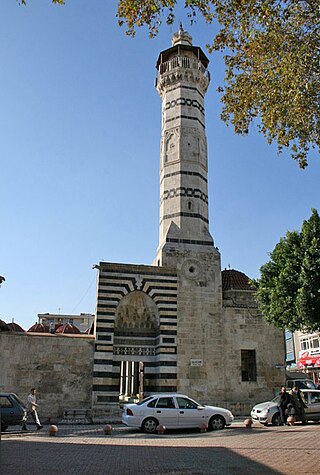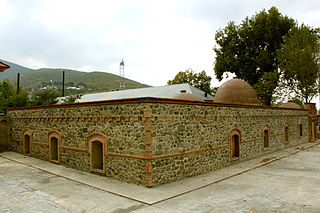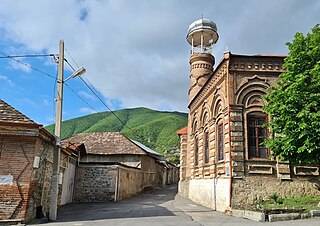
Shaki is a city in northwestern Azerbaijan, surrounded by the district of the same name. It is located in the southern part of the Greater Caucasus mountain range, 240 km (150 mi) from Baku. As of 2020, it has a population of 68,400. The center of the city and the Palace of Shaki Khans were inscribed in the UNESCO World Heritage List in 2019 because of their unique architecture and history as an important trading center along the Silk Road.

Itchan Kala is the walled inner town of the city of Khiva, Uzbekistan. Since 1990, it has been protected as a World Heritage Site.

Po-i-Kalan, or Poi Kalan, is an Islamic religious complex located in Bukhara, Uzbekistan. The complex consists of three parts, the Kalan Mosque, the Kalan Minaret to which the name refers, and the Mir-i-Arab Madrasah. The positioning of the three structures creates a square courtyard in its center, with the Mir-i-Arab and the Kalan Mosque standing on opposite ends. In addition, the square is enclosed by a bazaar and a set of baths connected to the Minaret on the northern and southern ends respectively.

The Great Mosque of Adana, also known as the Ramazanoglu Mosque, is a mosque from the 16th century in Adana, Turkey. It forms part of a complex (külliye) that includes a madrasah and a mausoleum (türbe). The complex is on Kızılay Street, next to the Ramazanoğlu Hall.

Yukhari Govhar Agha Mosque (Azerbaijani: Yuxarı Gövhər Ağa məscidi, is a mosque located in the city of Shusha, Azerbaijan. The mosque also bears the name Boyuk Juma of Govhar Agha.

The Musalla complex, also known as the Musallah Complex or the Musalla of Gawhar Shah, is a former Islamic religious complex located in Herat, Afghanistan, containing examples of Timurid architecture. Much of the 15th-century complex is in ruins today, and the buildings that still stand are in need of restoration. The complex ruins consist of the five Musallah Minarets of Herat, the Mir Ali Sher Navai mausoleum, the Gawhar Shad Mausoleum, and the ruins of a large mosque and a madrasa complex.

Gilahli Mosque - is a historical mosque located in the city of Sheki, built in the 18th century. The mosque was constructed in 1749 by Sheki Khan Haji Chalabi Khan. In 1805, Haji Shamseddin Bey rebuilt the mosque in the same location. After this reconstruction, the mosque began to be known among the people as the "Haji Shamseddin Bey Mosque".

Beyler Mosque is a historical and architectural monument which is located in the city of Baku, in a historical part of Icherisheher, opposite the “Murad” Gate of the Shirvanshah Palace Complex.

Shaki Khan's Mosque, previously First Khan Mosque is an 18th-century Azerbaijani mosque located in the city of Shaki.

The Underground Bath or Abdulsalam Bath, located in Sheki, Azerbaijan, is a 19th- century landmark building. Situated in the heart of the Upper Main State Historical-Architectural Reserve, it is no longer used as intended.

Imam Ali Mosque is a historical and architectural mosque located in the city of Sheki, Azerbaijan.

Omar Efendi Mosque is a historical and architectural monument of the 19th century located in the city of Shaki, Azerbaijan.

The Godak minarali mosque is a historical-architectural monument of the 19th century. It is located in the territory of the Yukhari Bash State Historical-Architectural Reserve in Sheki, Azerbaijan.

Sakinakhanim mosque is a historical architectural monument built in 1854 in the city of Guba, Azerbaijan.

Muhammad Aminkhan Madrasah is an architectural monument in Khiva (1852–1855). Built by Muhammad Amin Bahadur Khan. The Madrasah is located in the western part of the Itchan Kala. It was built in 1852–1855 with the funds and decree of the Uzbek ruler Muhammad Aminkhan. Muhammad Aminkhan Madrasah is the largest and most tiled in comparison to other Khiva madrasahs.

Abdullakhan madrasah is an architectural monument located in the north of the Koshmadrasa ensemble in Bukhara, Uzbekistan. This madrasah, which is a perfect example of the architecture of the Uzbek ruler Abdullah II, demonstrates all the creative achievements of Bukhara architecture in the 16th century.

Govkushon madrasah is an architectural monument in Bukhara, Uzbekistan. Madrasah built by Khojabor Khojas. It is part of Khoja Gaukushan Ensemble. It is an object of cultural heritage of Uzbekistan. The madrasah building of Khoja-Govkushon architectural ensemble was built in the historical center of Bukhara (Uzbekistan) in 1562-1565 during Shaybani ruler Abdulla Khan II at the expense of Khoja Saad, the sheikh of Dzhoybor. Khoja Sa'd is known by the nickname "Khoja Kalon", which is reflected in this name complex.

Ağvanlar bath is a monument built in Shaki, Azerbaijan in the 19th Century.

Juma Mosque, also known as the Minaret Mosque, is a mosque and historical-architectural monument located in the city of Balakən, Azerbaijan. The construction of the mosque lasted 10 years and was completed in 1877.

Juma Mosque (Qabala) is a historical-architectural monument from the 19th–20th centuries, located in the city of Qabala, Azerbaijan.



























